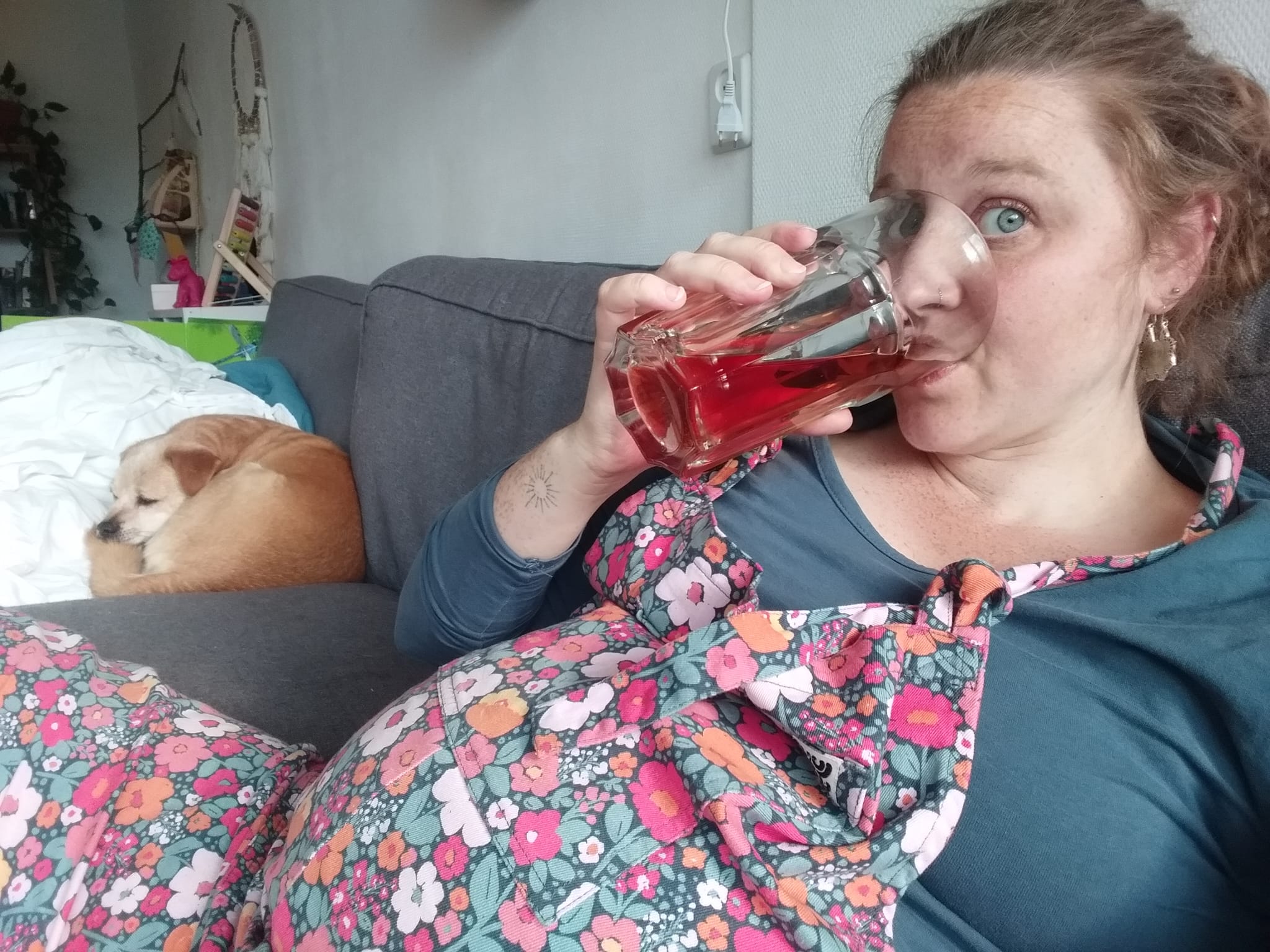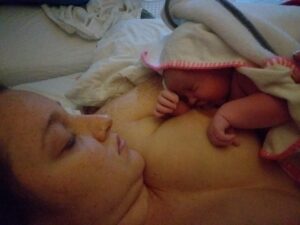As a birth doula, I see time and again how the initiation of breastfeeding in our society is under immense pressure and is undermined from the very beginning. This often happens through the routine use of rough techniques, bottles, and formula, rather than supporting parents in how to actually breastfeed. I have strong feelings about this. And it’s preventable.

Know What You Want and Stand Firm in Your Decision
Breastfeeding in today’s society requires parents with a solid mindset. It’s not an easy task—it comes with a lot of ups and downs. Navigating those ups and downs is part of the parenting process. So, are you planning to breastfeed? Decide it, and commit fully. Here’s how you’re going to succeed:

We tend to think that parents need to be rescued the moment they get emotional. And to be honest, that’s exactly what we project. Learned helplessness is a real issue. Emotions are elusive and confronting. So we rush to fix the emotion, to make things “easier.” That’s where it already starts to go wrong. But no. You can do this. Not being able to breastfeed due to physical reasons is extremely rare. Although it seems to happen “remarkably often”… hmm…
Let’s not forget: the Netherlands happens to be a major producer of several formula brands. So what does the economy gain from all those breastfed babies? What does the economy gain from you when you invoke your breastfeeding rights? Pumping rights? Extended parental leave?
Navigating through your emotions and staying the course gives you the boost you need to stay focused on your mission—and not fall into the trap of the “easier” way out. You will be tested. Truly.
After over six years of breastfeeding two children—both with tough starts—diving deep into every piece of information available, doing research, seeking lactation advice, completing a lactation support training, and guiding doula families and other parents through their breastfeeding journey, I dare say there are several factors you can control that greatly influence your chances of success.
Here’s my recipe for success. Completely free—because I believe every parent deserves access to solid, empowering information.
Got questions? Just send me a message!
Get educated during your pregnancy!
Seriously… this one is essential. Take a breastfeeding course—preferably one with videos so you can rewatch them while feeding. I cannot emphasize this enough. Give yourself this gift.
I’m a diehard fan of lactation consultant (IBCLC) Teddy Roorda (not sponsored).
Look up some certified lactation consultants in your area via: https://lactatiekundige.nl/ and write their phone numbers down in your birth plan.
Let your maternity care organization know that you plan to breastfeed and that you would like to be supported by someone with solid experience in this area. If that person isn’t available, ask whether they offer separate lactation support visits with them.
Get your reliable info from: https://www.borstvoeding.nl/
Follow the “Borstvoedingsforum” (Dutch Breastfeeding Forum) on Facebook.
DO NOT keep formula (not even sample packs), bottles, or breast pumps in the house “just in case.” This is a surefire way to interfere too early with your breastfeeding journey—and that’s pure sabotage. Keep your eyes on your goal.
What you should have on hand:
-
Comfortable tops
-
Nursing tops/bras without underwire that can hold breast pads
-
Washable breast pads
-
Nipple cream (lanolin/coconut oil/sheabutter)
-
A warm cardigan
-
A white cabbage (yes, grandma’s advice—but it works wonders!)
-
Breast milk storage bags to collect any leaking milk
-
A back support pillow for sitting up in bed (you can rent this at your local maternity care shop)
-
A water bottle—for YOU
-
An endless supply of good snacks
Limit your maternity visitors.
Ask your maternity nurse or your partner to send visitors home after a maximum of 30 minutes. And not everyone needs to visit in that first week. This is your bubble time. Choose wisely.
This time is SACRED.
Borstvoedingssucces in de kraamweek, meer tips!
Programmeer je brein
Colostrum IS MELK
In je zwangerschap kan het zijn dat je al wat olieachtige druppeltjes verliest uit je tepel. Dit is colostrum. De eerste zeer voedzame voeding van je baby. Boordevol voedingsstoffen en antistoffen. Gemaakt om het maagje en de darmen te laten wennen en voor te bereiden op grotere hoeveelheden voeding door er een beschermlaagje in te leggen.
Als je voor de bevalling nog geen colostrum verliest uit de borst, betekent dit niet dat je geen voeding hebt voor je kindje. Je lekt gewoon niet.
Borstvoeding wordt makkelijk NA DE OEFENTIJD.
Ja. Borstvoeding is zeker makkelijk. NA het harde werken in de eerste weken. Daarin kan borstvoeding ook gewoon heel zwaar, frustrerend en kut zijn. In de eerste weken ben je bezig met leren. Zie dit ook zo.
Jij bent in staat om door te zetten als het moeilijk is
Je hebt alles in huis om tot de bodem uit te zoeken wat jullie nodig hebben om borstvoeding te kunnen geven. Ook als het niet direct soepel loopt. Laat je dus niet van je missie afleiden. En durf te investeren in goede begeleiding als je er niet uitkomt.
Baby mag afvallen
Je baby mag na de geboorte afvallen, dit is een normaal ingebouwd proces, om het lijfje van je baby te laten wennen aan de nieuwe voedingssituatie, waarin het niet meer gevoed wordt via de navelstreng. Je baby heeft hiervoor wat extra spekjes gekregen.
- Tot 5 – 10% afvallen bij een baby met een gezond geboortegewicht is normaal.
- Het welzijn van je kindje beoordeel je ook op: Alertheid, natte luiers, binnen de eerste dagen effectief drinken.
- Gaat je baby meer richting de 8% en blijft het afvallen? Dan is het tijd om te overleggen met een lactatiekundige IBCLC.
Borstvoeding mag ongemakkelijk en gevoelig zijn (dat hoort erbij in het begin), maar hoort geen pijn te doen.
Jouw lijf en het lijfje van je baby moeten nog wennen aan nieuwe gevoelens. Dat is oke. Echte pijn is een duidelijk signaal dat er iets niet lekker loopt.
Wat kan ik in de eerste week verwachten?
Voor de geboorte:
Er is colostrum in de borst aanwezig. Sommige zwangeren lekken colostrum voor de geboorte en sommige zwangeren niet.
Geboorte:
Zorg na de geboorte direct voor huid-op-huid contact en een ongestoord gouden uur. Het liefste 3. In deze uren vindt de eerste voeding plaats. En deze moet zonder geforceerd gebeuren. Dit zorgt voor de eerste positieve imprint.
Dag 1, 2 en 3:
Deze dagen draaien om techniek oefenen en eerste effectieve voedingsmomenten.
De borst zit vol met colostrum: Dit is olieachtige gelige melk. DIT is ECHTE MELK. Je melk moet dus niet “Nog komen”. Het is er al.
Deze eerste melk heeft als functie: het beschermen van de darmwand, het laxeren van de eerste ontlasting en het voorzien van heel veel voedingsstoffen. Het maagje van je baby is zo klein als een knikker. Dat betekend dus ook dat je kindje vol zit na enkele druppels colostrum. Daarom heeft deze melk ook een hele hoge voedingswaarde.
Dit zijn de dagen dat er gemakkelijk naar kunstvoeding gegrepen wordt in het kader van “Je melk is er nog niet”. Je melk is er wel en er is heel weinig nodig. En je baby is je lichaam aan het vertellen dat het de komende dagen meer melk nodig heeft. Baby wordt geboren met wat reserve vanuit de buik. Daarom zie je de eerste dagen ook dat kindjes wat afvallen, om daarna weer aan te komen.
Heeft je baby na de eerste twee dagen nog geen goede ronde kunnen drinken? Klopt de drinktechniek niet? Neem contact op met de Lactatiekundige (IBCLC) uit je kraamplan.
Dag 3, 4 en 5:
Bij een goede drinktechniek merk je dat er stuwing ontstaat, want de borst wordt regelmatig geleegd. Dit geeft je lichaam het signaal: “Maak meer!”. Borsten met stuwing zijn harde, soms wat rode borsten die vanzelf melk lekken. Geen zorgen, dit reguleert zichzelf weer. Je borsten zijn nu (een beetje overdreven) veel melk aan het maken, om af te kunnen stemmen op de vraag van je baby. De stuwing neemt vanzelf weer af, na een paar weken kan je borstvoeding geven met zachtere borsten tussendoor. Dit is de periode dat baby’s meestal wat meer gaan drinken en weer aan beginnen te komen. Als de borst overvol is en er hard uitschiet, laat dan eerst je toeschietreflex aflopen (in een borstvoedingszakje), waarna je je baby aanlegt. Een te harde straal kan te heftig zijn voor een baby en dan ontstaat er “onrustig/slordig/gulzig” drinken. Dit ligt dan niet aan baby, maar aan de hogedrukspuit. Ga je borst niet leegkolven. Hiermee geef je je lichaam het signaal dat je baby zoveel gedronken heeft. En dus straks ook minimaal zoveel nodig heeft.
Dit zijn ook de dagen dat er veel onrust ontstaat onder ouders en zorgverleners. Baby heeft krampjes, lijkt niet goed aan te happen, ook als er wel “veel melk” lijkt te zijn. Hier ontstaan de gesprekken over tongriempjes.
Korte tongriempjes/lipbandjes ed. zijn wel degelijk een probleem als het gaat om de mogelijkheden van baby om goed aan te happen. Laat een gespecialiseerde lactatiekundige meekijken als dit vermoed wordt.
Weeg daarbij zelf ook de mogelijkheden af of de baby goed diep aan kan happen en het vacuüm kan behouden of dit met de drinktechniek van het mondje, of een teveel aan melk te maken heeft (niemand drinkt ontspannen met een harde straal in zijn keel).
Hoe weet ik of mijn techniek klopt?
Beoordeel je baby’s drinktechniek:
- Is het neusje van mijn baby is vrij om te ademen?
- Maakt mijn baby een grote hap?
Waarbij tepel en een stuk van de areola diep in de mond van je kindje zit. - Zit de tepel tegen de zachte achterkant van de mond aan?
Het ongemak/pijn verdwijnt binnen enkele seconden na het aanleggen. - Houdt baby het vacuüm goed vast (enkele minuten)?
Hoor ik geen tikgeluiden van lucht die langs de tepel naar binnen glipt? De lip hoeft niet perfect naar buiten gekruld te zijn om een goed vacuüm te kunnen maken. - Zie ik de kaak van baby goed open en dicht gaan?
- Hoor ik slikgeluiden tijdens het drinken?
Beoordeel je eigen houding:
- Mijn schouders zijn laag
- Ik zit wat achterover
- Mijn lijf is ontspannen
- Er zitten geen kledingstukken in de weg
- Mijn baby maakt contact met het buikje tegen mijn buik
Kraamzorg: Spreekt u borstvoeding?
Een kraamverzorgster met borstvoedingservaring kan je:
- Vertellen hoe vaak je baby aangelegd moet worden
- Met haar eigen handen technisch ondersteunen in het diep laten aanhappen van je baby aan de borst
- Ze kijkt technisch meekijken naar hoe de tepel weer uit de mond van je baby komt en of de baby een goed vacuüm maakt rondom je tepel.
- Ook kan zij je meerdere aanlegposities uitleggen
- jou coachen op je houding terwijl je voedt .
In de praktijk zijn er ook veel kraamverzorgenden met onvoldoende borstvoedingsscholing en praktijkervaring. - Signaleren als baby: ondiep aanhapt, geen vacuüm kan houden, refluxklachten vertoont, niet comfortabel ligt.
- Signaleren als baby niet genoeg natte luiers/poepluiers produceert
- Signaleren als baby niet alert is
Borstvoedings-saboterende acties die duiden op onvoldoende ervaring:
- Zelf beginnen over kunstvoeding
- Zelf beginnen over flesjes geven
- Onrustig zijn over “niet weten hoeveel erin gaat”.
- Helpt je niet hands-on bij het creëren van een diepe aanhap van je kindje aan de borst.
Hulp van een Lactatiekundige IBCLC
Ondersteuning van een lactatiekundige hoef je echt niet lang mee te wachten. Ouders wachten hier vaak mee tot de frustratie zo hoog opgelopen is, dat ze het niet meer zien zitten. Onnodig wat mij betreft. Dit is een stukje zelfliefde ook als dit geld kost. Reken dit dus in voor je kraamweek. Een goede lactatiekundige IBCLC is wat mij betreft goud waard. En echt onmisbaar bij zorgen. Soms is een telefonisch overleg voldoende, maar vaak komen ze op huisbezoek en kijken heel gericht naar jouw vraag.
Lactatiekundigen (IBCLC) zijn medisch opgeleide professionals. Het zijn aanpakkers en gewend om Hands-on te werken. Ze kunnen de mondanatomie van je baby beoordelen en concrete adviezen geven over hoe je je kindje nog beter aan de borst kunt krijgen.
Het hands-on werken kan overweldigend voelen, dat voelde zo voor mij, maar ook voor vele andere ouders met wie ik mocht werken. Daarom is het van belang om ook hier te werken met consent geven: Je geeft bij je lactatiekundige aan: Dat je bij alles eerst uitgelegd wilt krijgen WAT ze wil doen en HOE ze het doet en WAT jij dan gaat ERVAREN. Let op deze laatste is hierin onmisbaar. En dat jij dan, wanneer je het goed begrijpt: expliciet JA of NEE kunt zeggen.
